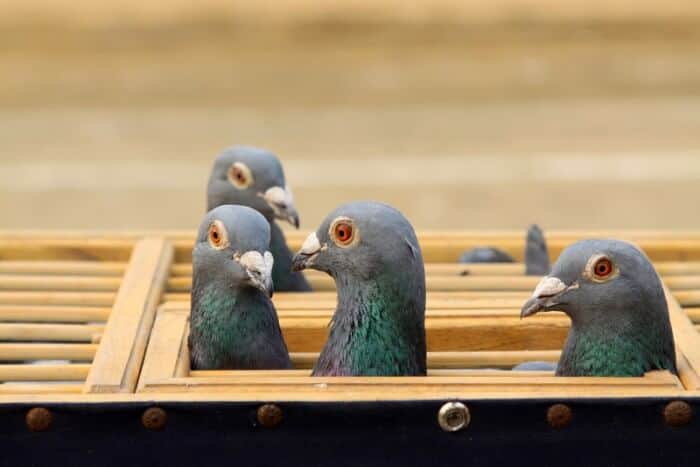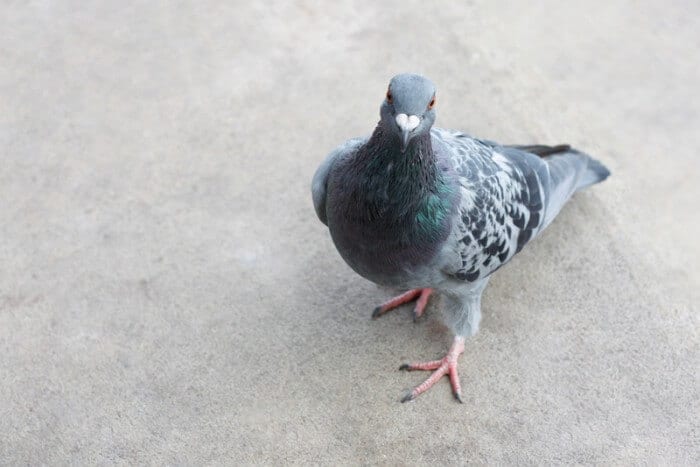If you’ve ever watched a pigeon walking around, you’ve likely noticed that their heads tend to bob as they move.
Head bobbing is such an iconic part of a pigeon’s behavior and something you’re probably quite used to if you have pet pigeons. Have you ever wondered why do pigeons bob their heads?
Scientists have studied pigeon behavior for many years and a study in 1978 found some interesting reasons for the head movements of pigeons.
Is it Bobbing?
To the untrained eye, it might appear that pigeons are bobbing their heads. However, what researchers have found is that pigeons are actually moving their heads forward.
Using video footage made during the study, scientists discovered that there are two distinct movements that the pigeons are making.
The first is a thrusting movement, which is when the pigeon’s head moves forward, usually about five inches.

The second movement is called the hold phase, where the head stays where it is as the body continues to move forward. So it looks like the head is bobbing when in reality, it’s not.
Instead, the pigeon’s head is moving forward, then staying in place as its body catches up. The motion happens so quickly that we see it as a bobbing motion.
How Often Do Pigeons Bob Their Head?
When a pigeon is walking, it cycles through the thrust and hold phase about five to eight times per second. Because it’s occurring so rapidly, we don’t see the cycles as they happen, nor do we see each phase individual of the other phase.
The reason why pigeons make this movement with their heads has a purpose, however, and may make them seem awkward, but is in fact, helping them survive.
How a Pigeon Sees

During the biggest study performed on pigeons and their head movements, which involved having them walk on a treadmill, researchers discovered that the “bobbing” motion they make when they move around has to do with how they see the world.
As the pigeons were walking on the treadmill, they didn’t move their heads as much, which let researchers know that because the surroundings were staying relatively stationary, the pigeons were seeing differently than if their surroundings were changing as they walked.
The groundbreaking discovery from the study was that pigeons cycle through the thrust and hold movements as a way to stabilize what they’re seeing around them.
So, the pigeon will push its head forward during the thrust phase, then hold it steady during the hold phase so it can see its surroundings as its body catches up. This method allows pigeons to be on the lookout for food sources as well as predators.
The research study also found that if a pigeon continued moving its head without the hold phase, it wouldn’t get a stable look at the world and its retinas would only pick up a blur in its surroundings.
This would put the pigeon at risk of becoming prey by its predators and would make it very difficult to look for food.
One interesting thing that researchers also discovered is, that if you hold your pigeon and walk around with it, it will still move its head because the surroundings are still moving around it.
These head movements are actually very similar to how humans see the world, but we use our eyes, rather than our entire heads to stay safe and function as we move through space.
A pigeon can move its eyes similarly to a human, but since it has a flexible neck and head, it also uses the thrust and hold motions to see what’s happening around it.
Looking for Food
Other ornithological theories compare pigeons to other ground-feeding birds, like chickens and cranes. Like these other species, pigeons tend to pick their food up off the ground, so their bobbing may be a way to assist them in doing so comfortably and efficiently.
When a pigeon zeros in on its food source, it can use this thrust and hold motion to align its body with its head, making it easier to pick up the food.
Other Ideas
Though the treadmill study debunked some of what other scientists felt was the reason for a pigeon’s head bobbing, some of those ideas still exist and research continues to be done to find out more.
Some feel that the head bobbing aids in balance and assists a pigeon as it takes off. Once scientists learned about the vision link, they found that this probably isn’t the case.
Since the head movements are stabilizing what a pigeon sees in its environment, it likely isn’t a necessary way to keep them on their feet and prevent them from tipping over.
Your Pet Pigeon
As a pigeon owner, you probably understand your pigeon well and have gotten to know it during its time with you. If you ever notice any issues with your pigeon’s gait or it appears that the thrust and hold movements aren’t happening properly, you may want to have your pigeon looked at by a veterinarian. There could be a vision issue going on and that’s something to investigate as soon as possible.
Now that you know why a pigeon bobs its head when it walks around, you can sit back and enjoy watching it happen. It has a purpose and that makes it look a whole lot less awkward and silly.
